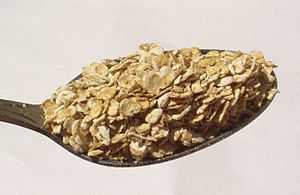Rolled oats

| Nutritional value per 100 g (3.5 oz) | |
|---|---|
| Energy | 379 kcal (1,590 kJ) |
|
67.70 g | |
| Sugars | 0.99 g |
| Dietary fiber | 10.1 g |
|
6.52 g | |
|
13.15 g | |
| Vitamins | |
| Vitamin A equiv. |
(0%) 0 μg |
| Thiamine (B1) |
(40%) 0.460 mg |
| Riboflavin (B2) |
(13%) 0.155 mg |
| Niacin (B3) |
(8%) 1.125 mg |
|
(22%) 1.120 mg | |
| Vitamin B6 |
(8%) 0.100 mg |
| Folate (B9) |
(8%) 32 μg |
| Vitamin B12 |
(0%) 0.00 μg |
| Choline |
(8%) 40.4 mg |
| Vitamin C |
(0%) 0 mg |
| Vitamin D |
(0%) 0 μg |
| Vitamin E |
(3%) 0.42 mg |
| Vitamin K |
(2%) 2.0 μg |
| Trace metals | |
| Calcium |
(5%) 52 mg |
| Iron |
(33%) 4.25 mg |
| Magnesium |
(39%) 138 mg |
| Manganese |
(173%) 3.630 mg |
| Phosphorus |
(59%) 410 mg |
| Potassium |
(8%) 362 mg |
| Sodium |
(0%) 6 mg |
| Zinc |
(38%) 3.64 mg |
| Other constituents | |
| β-glucan (soluble fiber)* | 4 g |
|
| |
| |
|
Percentages are roughly approximated using US recommendations for adults. Source: USDA Nutrient Database | |
Rolled oats are traditionally oat groats that have been de-husked, steamed and then rolled into flat flakes under heavy rollers before being stabilized by being lightly toasted. The oat, like the other cereals, has a hard, inedible outer husk that must be removed before the grain can be eaten. After the outer husk (or chaff) has been removed from the still bran-covered oat grains, the remainder is called oat groats. Oat groats are a whole grain that can be used as a breakfast cereal; various forms of oatmeal and rolled oats, and pinhead oats are cooked to make porridge or porage.[1] Steel-cut oats (pinhead oatmeal) are oat groats that have been chopped into smaller pieces before any steaming and thus retain bits of the bran layer. Since the bran layer, though nutritious, makes the grains tough to chew and contains an enzyme that can cause the oats to go rancid, raw oat groats are often further steam-treated to soften them for a quicker cooking time (modern "quick oats") and to denature the enzymes for a longer shelf life.
Rolled oats that are sold as oatmeal usually, but not always, have had the tough bran removed. They have often, but not always, been lightly baked or pressure-cooked or "processed" in some fashion. Thick-rolled oats are large whole flakes, and thin-rolled oats are smaller, fragmented flakes. Oat flakes that are simply rolled whole oats without further processing can be cooked and eaten as "old-fashioned" oatmeal, but more highly fragmented and processed rolled oats absorb water much more easily and therefore cook faster, so they are sometimes called "quick" or "instant" oatmeal. Oatmeal can be further processed into coarse powder, which, when cooked, becomes a thick broth. Finer oatmeal powder is often used as baby food. Rolled oats are also often the main ingredient in granola and muesli.
Rolled oats can be used to prepare oat flour at home by pulsing rolled oats in a food processor.[2]
Whole oats are an excellent source of thiamine, iron, and dietary fiber. Whole oats are also the only source of antioxidant compounds known as avenanthramides; these are believed to have properties which help to protect the circulatory system from arteriosclerosis. Oat products also contain beta-glucan, which may help people with Type 2 diabetes control their blood glucose level, and might also help stimulate the immune system to fight off bacterial infections.
Fineness and properties
Oat grains can be sold whole (groats), ground into oatmeal or Scottish oats, steamed and rolled into flakes of varying thickness, or cut into two or three pieces, steel-cut. Groats can be used as other whole grains; they are a little softer than wheat berries. Rolled oats can be used for many purposes; the bigger the flakes, the chewier the result. They may be precooked—instant varieties. Steel-cut, as a cereal, are much chewier. They are suitable as a breakfast cereal, but less so for baking, as they do not soften well.[3] If oat flour, prepared from rolled oats, is used alone, baked goods will not rise or hold together; oat flour must be mixed with other flours in baking.[4]
See also
References
- ↑ Guardian newspaper: How to cook perfect porridge
- ↑ The Sparkpeople cookbook: love your food, lose the weight, Galvin, M., Romnie, S., May House Inc, 2011, ISBN 978-1-4019-3132-2, page 98.
- ↑ "Steel Cut, Rolled, Instant, Scottish?". Bob's Red Mill. Retrieved 9 October 2012.
- ↑ http://www.wisegeek.com/what-is-oat-flour.htm "What is oat flour?" wisegeek.com. Retrieved 07 July 2013.